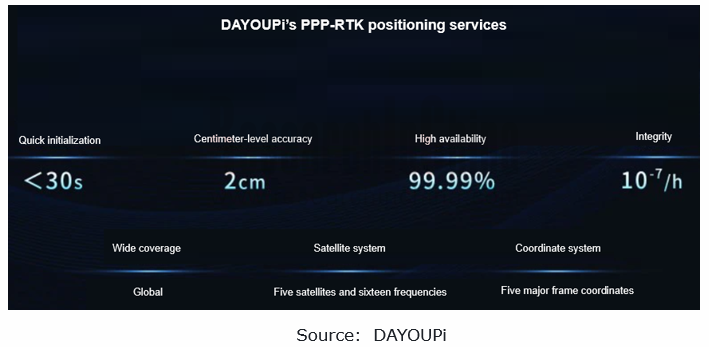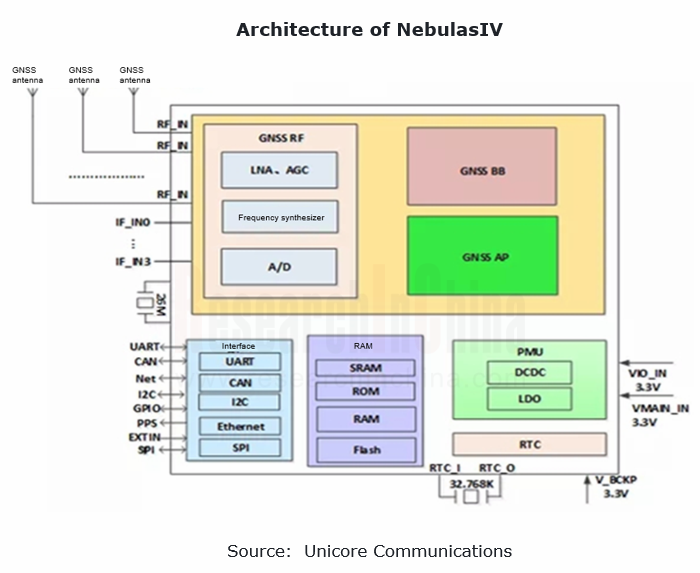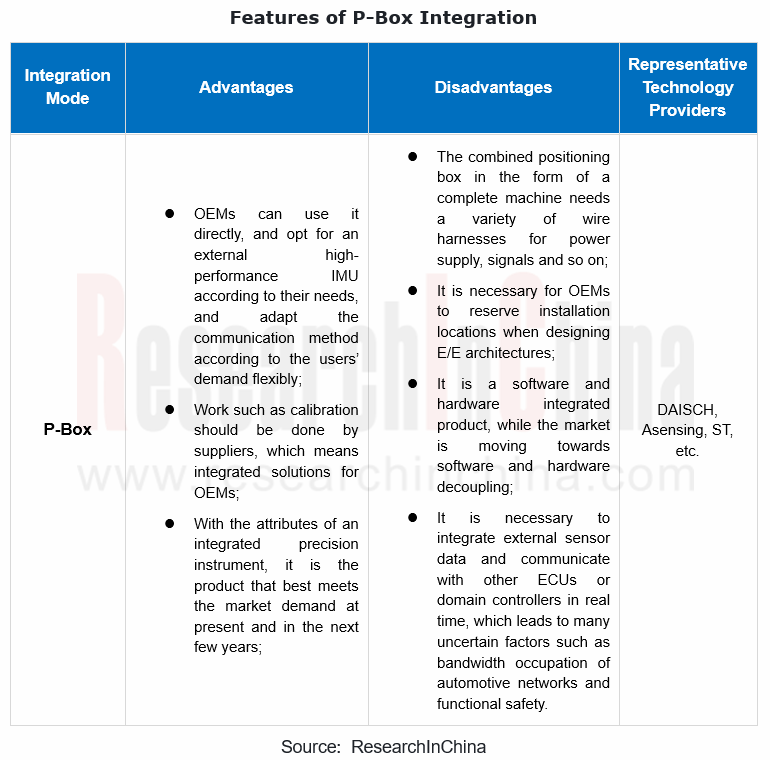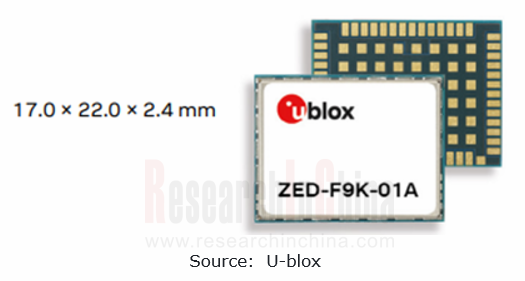High Precision Positioning Research: four forms of mass-produced integrated high-precision positioning products
With the continuous development of autonomous driving, the demand for high-precision positioning technology is increasing. As intelligent vehicles tend to pre-embed hardware, ever more passenger cars are equipped with high-precision positioning hardware. After mass production and delivery, higher-level functions can be realized via OTA updates.
Suppliers accelerate mass production and installation of high-precision positioning products as a standard configuration of vehicles
An impressive number of models launched from 2022 are equipped with high-precision positioning technology. Among them, NIO, Xpeng, Li Auto, Hozon, Human Horizons, and BAIC ARCFOX offer high-precision positioning as a standard configuration on their new models in 2022. Conventional OEMs have also accelerated their deployment, for instance, Great Wall Tank 500, Great Wall Mecha Dragon, Changan Deep Blue SL03, SAIC Rising Auto R7, SAIC MAXUS G90, Chery JETOUR Dasheng, Cadillac LYRIQ have unveiled versions with standard high-precision positioning and those with optional high-precision positioning. According to the statistics of ResearchInChina, China mass-produced more than 280,000 passenger cars equipped with high-precision positioning from January to October 2022, with the installation rate of about 1.8%.
Large-scale installation of high-precision positioning in vehicles, especially centimeter-level high-precision positioning that meets L4/L5 requirements, will be only achieved on the premise of higher positioning accuracy through high-precision positioning services (such as RTK/PPP-RTK) and lower costs. For high-precision positioning suppliers, independent development of core software and hardware can significantly reduce costs.
(1) Basic positioning service technology
The fusion of high-precision positioning hardware technology with RTK or PPP-RTK technology can effectively improve positioning accuracy, realize centimeter-level positioning and cater to the requirements of different levels of autonomous driving. At present, Chinese vendors such as Qianxun SI, Sixents Technology, China Mobile, and Beidou TruePoint can provide RTK or PPP-RTK positioning services to help OEMs develop autonomous driving.
Sixents Technology: so far, it has built more than 2,800 CORS base stations in China, self-developed terminal RTK algorithms and integrated navigation algorithms. Based on the principle of virtual reference stations and precise single-point positioning technology, it has developed its own "Yunge" computing platform to calculate various spatial errors and build a "network-cloud-terminal" integrated solution through its self-developed terminal RTK algorithms and terminal integrated navigation algorithms. This solution will be able to provide all-weather, real-time centimeter-level high-precision positioning services with 5 systems and 16 frequency points. The high-precision positioning services of Sixents Technology can achieve integrity monitoring and integrity output from satellite to cloud, and to terminals.
In the past two years, Sixents Technology has secured a number of orders from WM Motor, Inceptio Technology and TuSimple in the field of intelligent driving, and has built cooperation with many upstream and downstream enterprises of Beidou, such as Dongfeng Yuexiang, Autowise, DiDi Bike, INTEST, u-blox and Kunchen.

DAYOUPi: in early January 2023, it officially launched the PPP-RTK global satellite positioning service. Through comprehensive processing of base station data, it establishes error models such as ionospheric delay and tropospheric delay of the entire network, and generates a set of state corrections including satellite orbit, clock difference, ionosphere, etc., and sends it to the vehicle for position calculation, with rapid convergence in less than 30 seconds and positioning accuracy of 2cm.

PPP-RTK embodies apparent advantages in the market, and features integrity of positioning result output:
1.Short convergence time: atmospheric corrections and phase fractional bias products provided by ground-based reference networks are exploited to achieve fast convergence;
2.Strong privacy: terminal location data need not to be uploaded to operator platforms;
3.Wide coverage: mobile communication and satellite broadcasting are supported simultaneously and can complement each other to achieve global positioning;
4.Effective cost reduction: in view of the low communication bandwidth requirements, satellite broadcasting can be used, because the amount of calculation and broadcast data hereby does not increase in a linear manner, with the hike in the number of users. In addition, the demand for base stations is relatively low, which can effectively reduce the corresponding costs;
At present, PPP-RTK technology is an effective solution to the problems about costs and positioning accuracy. It is expected to gradually become the preferred technology enabling high-precision positioning services in the intelligent driving solutions of OEMs.
(2) Positioning hardware products
As for GNSS localization, China-based BYNAV Technology, CHCNAV, Qianxun SI, and Unicore Communications have all self-developed chips or board cards.
Unicore Communications: the Beidou high-precision positioning module UM982, launched in July 2022, is designed based on the NebulasIV chip developed by Unicore Communications independently. It enables RTK positioning and dual-antenna directional calculation. NebulasIV integrates all RF information processing, baseband signal capture and tracking, high-precision centimeter-level algorithms, anti-jamming algorithms, etc. It is a 22nm GNSS SoC combining RF baseband with high-precision algorithms.

In terms of IMU localization, Chinese vendors such as DAISCH, Asensing and W-Ibeda have mass-produced IMU modules, while foreign vendors still dominate IMU chips.
High-precision positioning boxes (P-Box) have been mass-produced and installed in vehicles.
High-precision positioning hardware for mass-produced passenger cars mainly includes the following four integrated product forms: (1) Independent positioning boxes such as P-Box and Map-Box; (2) SMD modules that integrate high-precision positioning into T-Box or domain controllers; (3) GNSS/IMU integrated into T-Box (wireless communication module); (4) GNSS and IMU modules that are separately deployed in different positions in the vehicle.
Since P-Box can be quickly integrated into vehicles, it has become the best choice for most OEMs, especially conventional OEMs, to mass-produce and install high-precision positioning swiftly.

STMicroelectronics: at the electronica South China in November, 2022, ST exhibited its P-Box, which consists of ST's multi-frequency multi-constellation GNSS chip (STA9100/STA8100), positioning engine (STA1835), IMU (ASM330LHB) and power management system (LDO DC-DC L5965). It can realize lane-level positioning.
ST's P-Box complies with ASIL- B, with the GNSS chip involved conforming to ASIL-B. The positioning engine, power management system and IMU all support ASIL-B automotive applications.

Asensing: Focusing on the high-precision positioning industry, Asensing’s high-precision positioning solutions satisfy ISO 26262. The P-Box of Asensing integrates MEMS inertial navigation technology, RTK-GNSS and vehicle information (wheel speed, gear position, etc.), which conforms to ISO 26262 ASIL B.
Li L9, which went on the market in June 2022, and Changan Deep Blue SL03, which was unveiled in July 2022, are all equipped with Asensing’s P-Box. In addition, Asensing has been designated by Chery for its project.
The evolution of E/E architectures promotes the development of SMD positioning modules
OEMs that can develop their own algorithms have begun to explore the integration of high-precision positioning into the intelligent driving domain to reduce the use of wiring harnesses and interfaces. In order to follow the development trend for domain centralization and multi-domain fusion architectures, suppliers are aggressively deploying SMD high-precision positioning products in addition to P-Box. At present, BYNAV Technology, Aceinna, U-blox, etc. have introduced SMD high-precision positioning modules.
U-blox: in November 2022, u-blox announced the u-blox ZED-F9K-01A, a high-precision GNSS module with embedded advanced hardware, software, and latest generation IMU to provide an advanced, self-contained positioning solution.
The u-blox ZED-F9K-01A natively supports the u-box PointPerfect GNSS augmentation service. It delivers multiple GNSS and IMU outputs in parallel to support all possible architectures, including a 50 Hz sensor-fused solution with very low latency. Operation up to 105 oC makes it possible to integrate the product anywhere in the car without design constraints.

Automotive High-precision Positioning Industry Research Report, 2023 by ResearchInChina highlights the following:
 High-precision positioning industry policy, market size, market structure, etc.;
High-precision positioning industry policy, market size, market structure, etc.;
 The development, providers and products of main high-precision positioning technologies (including GNSS, IMU, GNSS+RTK+IMU, etc.);
The development, providers and products of main high-precision positioning technologies (including GNSS, IMU, GNSS+RTK+IMU, etc.);
 Development trends of of main high-precision positioning technologies, including automotive integration modes, fusion algorithms and application of PPP-RTK technology;
Development trends of of main high-precision positioning technologies, including automotive integration modes, fusion algorithms and application of PPP-RTK technology;
 High-precision positioning in main application scenarios (including production passenger cars, autonomous delivery, autonomous trucks, etc.) and the size of market segments;
High-precision positioning in main application scenarios (including production passenger cars, autonomous delivery, autonomous trucks, etc.) and the size of market segments;
 Main technologies, products, competitive advantages and cooperation of basic high-precision positioning service providers and positioning module suppliers.
Main technologies, products, competitive advantages and cooperation of basic high-precision positioning service providers and positioning module suppliers.
Passenger Car CTP (Cell to Pack), CTC (Cell To Chassis) and CTB (Cell to Body) Integrated Battery Industry Report, 2024
Passenger Car CTP, CTC and CTB Integrated Battery Industry Report, 2024 released by ResearchInChina summarizes and studies the status quo of CTP (Cell to Pack), CTC (Cell To Chassis) and CTB (Cell to ...
Software-defined Vehicle Research Report, 2023-2024 - Industry Panorama and Strategy
1. How to build intelligent driving software-defined vehicle (SDV) architecture?
The autonomous driving intelligent platform can be roughly divided into four parts from the bottom up: hardware platf...
Automotive DMS/OMS (Driver/Occupant Monitoring System) Research Report, 2023-2024
In-cabin Monitoring study: installation rate increases by 81.3% in first ten months of 2023, what are the driving factors?
ResearchInChina released "Automotive DMS/OMS (Driver/Occupant Monitoring Sys...
Automotive Functional Safety and Safety Of The Intended Functionality (SOTIF) Research Report, 2024
As intelligent connected vehicles boom, the change in automotive EEA has been accelerated, and the risks caused by electronic and electrical failures have become ever higher. As a result, functional s...
Autonomous Driving Map Industry Report,2024
As the supervision of HD map qualifications tightens, issues such as map collection cost, update frequency, and coverage stand out. Amid the boom of urban NOA, the "lightweight map" intelligent drivin...
Automotive Vision Industry Research Report, 2023
From January to September 2023, 48.172 million cameras were installed in new cars in China, a like-on-like jump of 34.1%, including:
9.209 million front view cameras, up 33.0%; 3.875 million side vi...
Automotive Voice Industry Report, 2023-2024
The automotive voice interaction market is characterized by the following:
1. In OEM market, 46 brands install automotive voice as a standard configuration in 2023.
From 2019 to the first nine month...
Two-wheeler Intelligence and Industry Chain Research Report, 2023
In recent years, two-wheelers have headed in the direction of intelligent connection and intelligent driving, which has been accompanied by consumption upgrade, and mature applications of big data, ar...
Commercial Vehicle Telematics Industry Report, 2023-2024
The market tends to be more concentrated in leading companies in terms of hardware.
The commercial vehicle telematics industry chain covers several key links such as OEMs, operators, terminal device ...
Automotive Camera Tier2 Suppliers Research Report, 2023
1. Automotive lens companies: "camera module segment + emerging suppliers" facilitates the rise of Chinese products.
In 2023, automotive lens companies still maintain a three-echelon pattern. The fir...
China Passenger Car Navigate on Autopilot (NOA) Industry Report, 2023
Intelligent driving is evolving from L2 to L2+ and L2++, and Navigate on Autopilot (NOA) has become a layout focus in the industry. How is NOA advancing at present? What are hotspots in the market? Wh...
Automotive Telematics Service Providers (TSP) and Application Services Research Report, 2023-2024
From January to September 2023, the penetration of telematics in passenger cars in China hit 77.6%, up 12.8 percentage points from the prior-year period. The rising penetration of telematics provides ...
Passenger Car Intelligent Chassis and Chassis Domain Controller Research Report, 2023
Passenger Car Intelligent Chassis and Chassis Domain Controller Research Report, 2023, released by ResearchInChina combs through three integration trends of brake-by-wire, steer-by-wire, and active su...
Automotive Smart Cockpit Design Trend Report, 2023
As the most intuitive window to experience automotive intelligent technology, intelligent cockpit is steadily moving towards the deep end of “intelligence”, and automakers have worked to deploy intell...
China Automotive Multimodal Interaction Development Research Report, 2023
China Automotive Multimodal Interaction Development Research Report, 2023 released by ResearchInChina combs through the interaction modes of mainstream cockpits, the application of interaction modes i...
Automotive Smart Surface Research Report, 2023
Market status: vehicle models with smart surfaces boom in 2023
From 2018 to 2023, there were an increasing number of models equipped with smart surfaces, up to 52,000 units in 2022 and 256,000 units ...
Passenger Car Intelligent Steering Industry Report, 2023
Passenger Car Intelligent Steering Industry Report, 2023 released by ResearchInChina combs through and studies the status quo of passenger car intelligent steering and the product layout of OEMs, supp...
Automotive High-precision Positioning Research Report, 2023-2024
Autonomous driving is rapidly advancing from highway NOA to urban NOA, and poses ever higher technical requirements for high-precision positioning, highlighting the following:
1. Higher accuracy: urb...